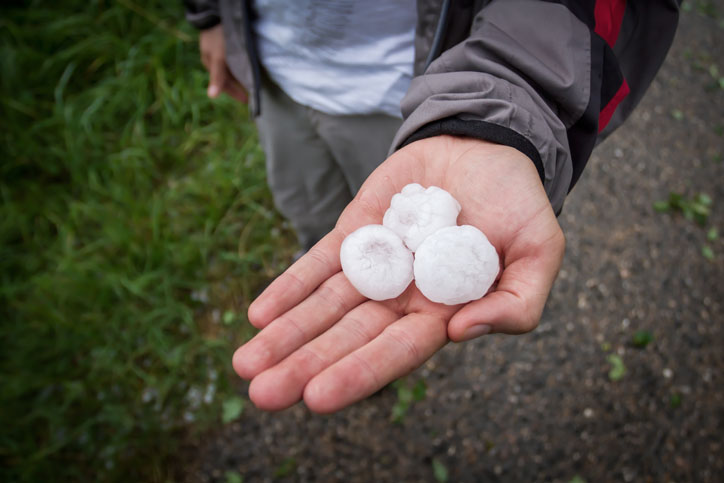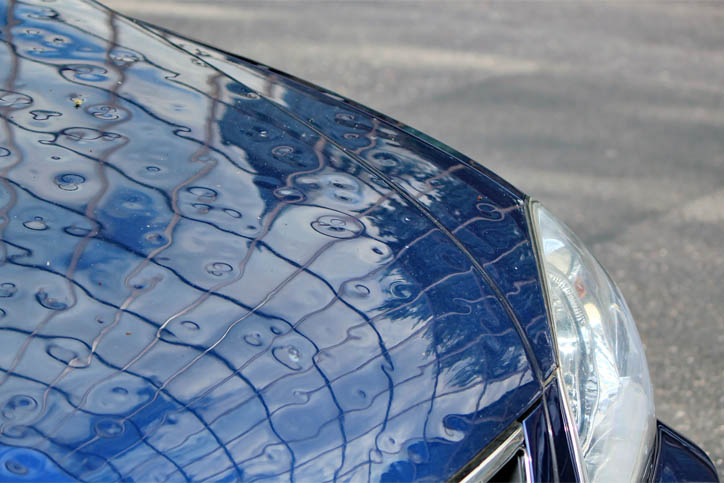Did You See Our Ad?

Click Here to Download our Hail Preparedness Toolkit
Colorado Knows Hail Storms
Spring and summer are hail season in Colorado, and the state is battered by large hail more often than any other place in North America.
Last spring Denver was pummeled with baseball-size hail. The storm was the most expensive Colorado has ever faced, leading to over 150,000 auto claims and 50,000 homeowners claims. In total, insured losses came to over $1.4 billion.
Hail starts quickly, often with little warning, but there are some things you can do prior to a storm to lesson the potential damage. There are also a few things you should do after the storm, to make sure your claim is processed and your property is repaired as fast as possible.
How to Prepare for Hail Right Now
1. Sign up for emergency alerts.
You can do this with the Colorado Division of Homeland Security and Emergency Management.
2. Make sure hail is covered in your insurance policies.
Get comprehensive auto insurance. The state doesn’t require it, but in the case of a major storm, you’ll be glad to have it. Last May’s hail storm occurred around rush hour, when people were either in their vehicles or those vehicles were parked in uncovered office lots, and the damage went far beyond cosmetic.
The ice particles were so big that many windshields were shattered, leaving cars non-drivable. A comprehensive policy will cover any damage and may help you pay for a rental while your car is fixed.
On your homeowner policy, read the fine print. Almost all homeowner policies cover hail and wind to some extent, but make sure that inherent coverage is enough. You don’t want to be underinsured when you have extensive roof and property damage.
3. Replace worn roof shingles.
Have your roof inspected and repair any weak points to prevent potential interior water damage.
4. If you’re upgrading or replacing a roof, use impact-resistant products.
This could keep you from having to replace your roof a second time.
5. Keep branches away from your house.
Trim back branches that hang over or near your house. Wind and hail can break large branches, which can, in turn, break your windows—or even worse, your roof!
6. Make sure outdoor pets and livestock can reach shelter, even if you’re not home.
There are multiple accounts of hail killing zoo animals and livestock. Make sure your large animals can access a barn, and consider installing a pet door for smaller animals, so they can escape the storm.
7. Have emergency water, lights, and food on hand.
Sometimes storms knock out utilities or make roads impassable. Have enough supplies on hand to keep everyone in your household comfortable for a few days.

What to Do When Hail is in the Forecast
1. Make sure your car is protected.
If you don’t have a carport or garage, buy a car cover or duct tape blankets over your car, making sure to completely cover the windshield. (But keep the duct tape as close to the underside of the car as possible, to keep the adhesive from damaging paint.)
2. Park on the side of a large building.
If no shelter is available, it may help to park beside a large building. Just make sure you park on the opposite side from the direction the wind is blowing! If you’re lucky, the building may act as a shield, and the hail may blow right past.
3. Move patio furniture, outdoor tools, and garbage cans to a sheltered area.
Hail could damage the furniture (and shatter glass-topped tables), but worse that than, the accompanying heavy winds may launch loose items at your house and cause major damage.
4. Stay away from windows and skylights.
And close any blinds or curtains, to guard against flying glass.
5. Never go out in the storm.
If the hail has already started, don’t go out to move your car or your patio furniture. Stay in a sheltered area and keep your animals in a sheltered area until the storm ends.
What to do After the Hail Storm
1. Assess and document property damage.
Check your car, your roof, and all around your house. If you find damage, take photos and do whatever you can to prevent more damage—cover your roof or broken windows with tarp to keep out rain, clear glass out of your car, so it isn’t able to further damage your seats, etc.
2. Call your insurance company.
The sooner you do this, the faster we can help you. Call your agent or 1-800-315-5998 for customer or claims support.
3. Select your repair company, but do it after you’ve received your claim adjuster’s estimate.
You want to make sure your service provider and adjuster are on the same page about how much a repair should cost. And save any receipts from supplies or repairs. Your may need them in order to receive reimbursement.
Worried that you’re not fully covered for hail and wind damage? Talk to a Colorado Farm Bureau Insurance agent today.
Sources:
Rocky Mountain Insurance Information Association (RMIIA)
Say Heck No to Hail Damage with these Tips (Buick GMC McKinney)

